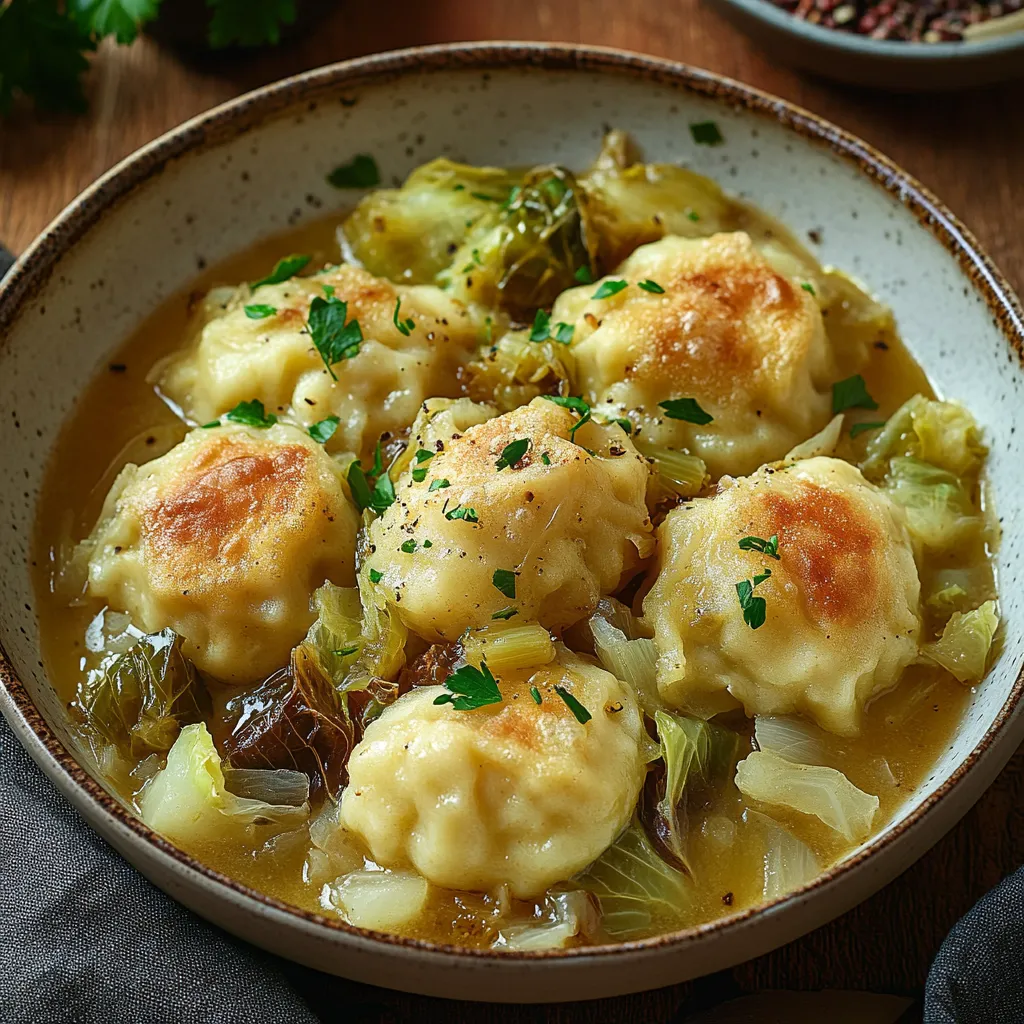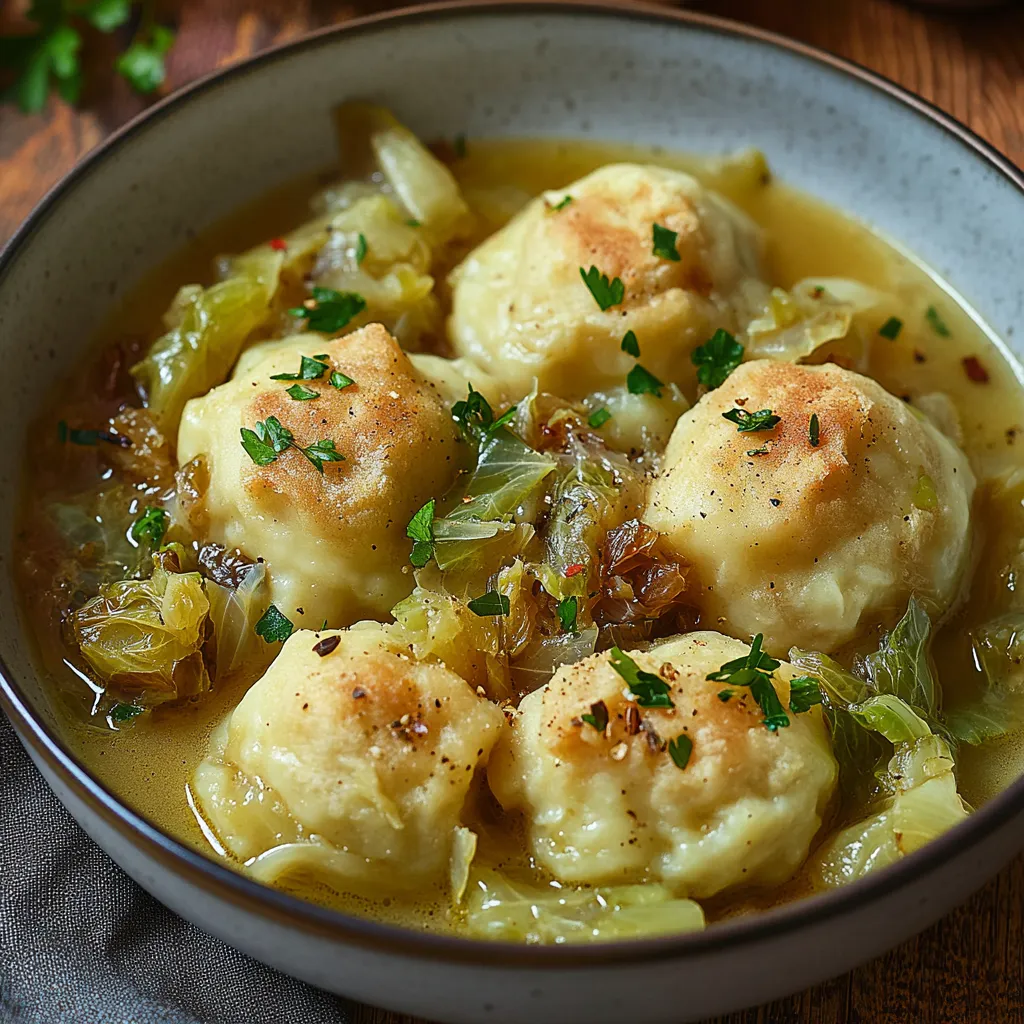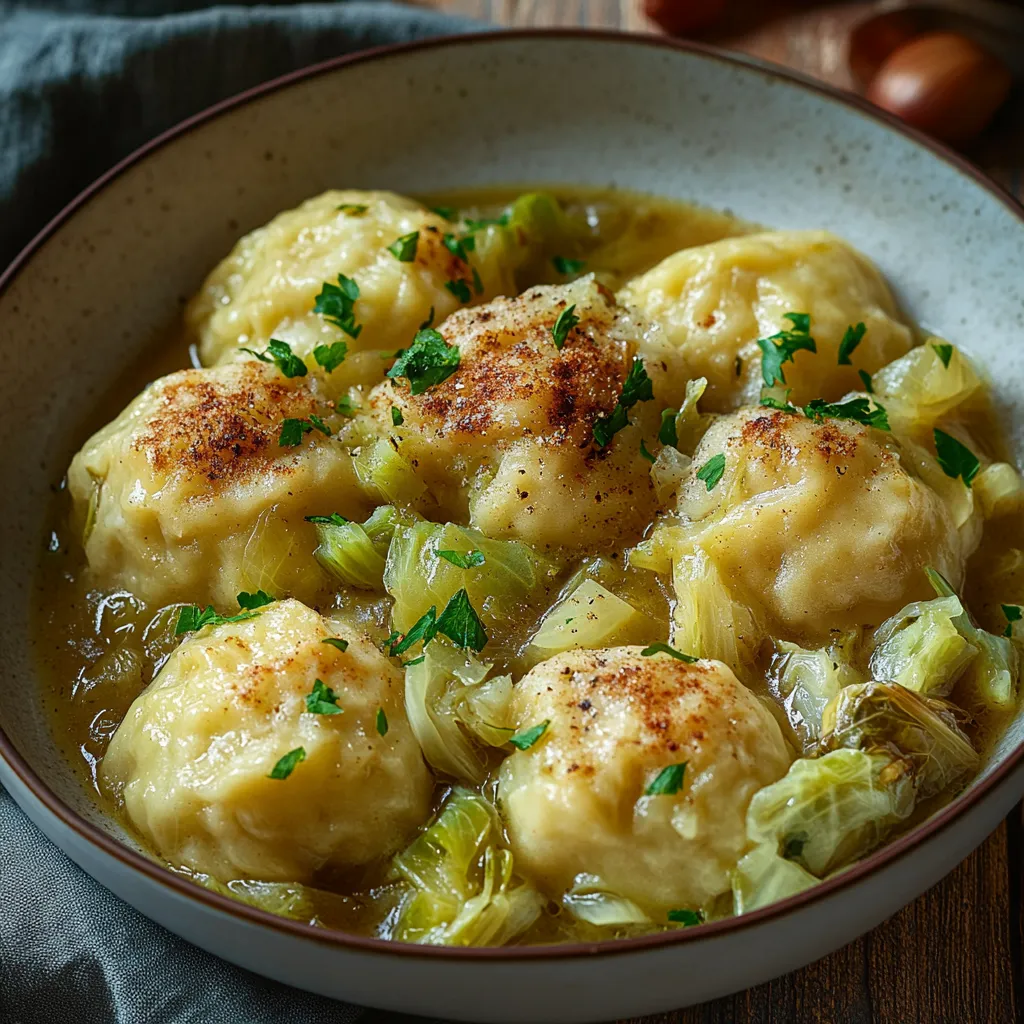 Pin it
Pin it
This hearty German Cabbage and Dumplings recipe brings authentic comfort food to your table with minimal fuss. The tender cabbage and pillowy dumplings combine to create a satisfying meal that warms you from the inside out.
I discovered this recipe during a cold winter when I was craving something substantial yet uncomplicated. After making it once, my family requested it weekly, and it's now our go-to comfort meal when temperatures drop.
Ingredients
- All-purpose flour: Creates the perfect dumpling texture that's neither too dense nor too light
- Dried thyme or parsley: Adds an aromatic herbal note that complements the cabbage beautifully
- Eggs: Bind the dumplings and provide richness without adding fat
- Butter: Creates the flavor foundation and adds necessary richness to the simple ingredients
- Cabbage: Is the star vegetable that becomes sweet and tender when properly cooked
- Stock: Provides depth of flavor and necessary moisture for cooking the cabbage properly
- Garlic powder: Infuses the dish with savory notes without overwhelming the delicate cabbage
- Fresh parsley: Brightens the finished dish with color and fresh flavor
Step-by-Step Instructions
- Prepare the dumpling mixture:
- Combine the dry ingredients in a large bowl, creating a foundation for perfect dumplings. The thyme or parsley incorporates flavor throughout, while the optional baking powder and soda will create lighter dumplings if you prefer that texture.
- Create the dumpling dough:
- Make a well in the center of your dry ingredients and pour in the whisked eggs. The key is achieving the right consistency not too wet or too sticky. Add milk gradually only if needed, watching for a stiff but workable dough.
- Cook the dumplings:
- Bring salted water to a rolling boil and drop tablespoon-sized portions of dough into the water. The hot water trick between scoops prevents frustrating sticking. Watch for them to float to the surface, which signals they're perfectly cooked about 3-5 minutes.
- Prepare the flavor base:
- Melt butter in your pot and cook the onions slowly until they develop a golden hue. This step builds the essential flavor foundation for the entire dish, so resist rushing these first 8-10 minutes.
- Cook the cabbage:
- Add the remaining ingredients to the pot and bring to a simmer. The covered cooking creates a gentle steam bath that transforms the cabbage from crisp to tender while maintaining its integrity. The stock prevents burning while adding flavor.
- Combine and serve:
- Gently fold the cooked dumplings into the tender cabbage, allowing them to absorb the flavorful juices. This final tossing melds the flavors together while keeping the dumplings intact.
 Pin it
Pin it
My grandmother used to make this recipe with cabbage from her garden, and she always insisted on adding the parsley at the very end. She would say "the green makes people eat with their eyes first," and she was absolutely right. The bright pop of color transforms this humble dish into something special.
Historical Context
This German cabbage and dumplings dish, known as "Krautnudeln" in some regions, has roots in frugal cooking traditions. Peasant families would make this satisfying meal using cabbage that stored well through winter months and simple flour dumplings that stretched limited resources. Many German immigrants brought this recipe to America, where it became a staple in German-American communities, especially in the Midwest. Each family typically develops their own variation, with some adding bacon, apples, or caraway seeds based on regional preferences.
Storage and Reheating
German Cabbage and Dumplings stores beautifully in refrigerated containers for up to four days. The flavors actually develop and intensify overnight, making this an excellent make-ahead dish. When reheating, add a splash of broth or water before warming on the stovetop over medium-low heat. Stir gently to prevent breaking the dumplings. This dish also freezes surprisingly well, though the dumplings may soften slightly upon thawing and reheating. For best results when freezing, slightly undercook the cabbage before adding the dumplings and freezing.
Ingredient Substitutions
If you prefer a healthier version, whole wheat flour can replace all-purpose flour for more nutritious dumplings, though they will be slightly denser. Red cabbage makes a colorful alternative to green cabbage and adds a slightly sweeter flavor profile. Vegetarians should stick with vegetable stock, while meat eaters might prefer chicken stock for added richness. For a flavor boost, add a tablespoon of caraway seeds to the cabbage or a teaspoon of ground caraway to the dumpling mixture. Dairy-free households can substitute olive oil for butter with minimal flavor loss.
 Pin it
Pin it
This dish is the perfect blend of frugality and flavor, delivering comforting warmth with every bite.
Frequently Asked Questions
- → Can I make the dumplings ahead of time?
Yes, you can prepare the dumplings up to 24 hours in advance. Cook them as directed, then store in an airtight container in the refrigerator. Gently reheat them in simmering water for 1-2 minutes before adding to the cabbage.
- → What type of cabbage works best for this dish?
Green cabbage is traditional and works best, but savoy cabbage can also be used for a slightly different texture and milder flavor. Red cabbage isn't recommended as it would change the color of the dish significantly.
- → How do I know when the dumplings are cooked properly?
Properly cooked dumplings will float to the surface of the boiling water. This usually takes about 3-5 minutes depending on their size. They should feel light and somewhat springy when touched with a spoon.
- → Can I make this dish vegetarian?
Absolutely! Simply use vegetable stock instead of chicken stock. The dish is already meat-free otherwise, making it an excellent vegetarian main course option.
- → What can I serve with German cabbage and dumplings?
This dish works well as a complete meal on its own, but pairs nicely with German sausages, pork roast, or schnitzel for meat eaters. A simple green salad or pickled vegetables make excellent side dishes to balance the richness.
- → How do I store and reheat leftovers?
Store leftovers in an airtight container in the refrigerator for up to 3 days. Reheat gently on the stovetop with a splash of stock or water to prevent drying out. Avoid microwave reheating if possible as it can make the dumplings rubbery.
